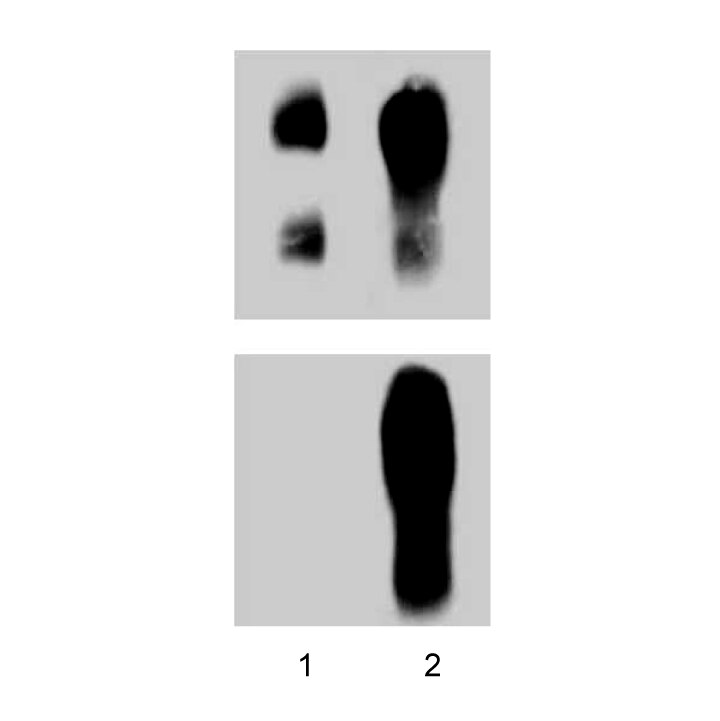Old Browser
This page has been recently translated and is available in French now.
Looks like you're visiting us from {countryName}.
Would you like to stay on the current country site or be switched to your country?
BD Transduction Laboratories™ Purified Mouse Anti-p120 Catenin (pY228)
Clone 21a/p120 Catenin (pY228)
(RUO)





Human Endothelial cells were treated with#1 mM pervanadate for 15 min at 37°C. The top panel was probed with p120 Catenin (cat.#610133) and the bottom panel was probed with p120 Catenin (pY228) (cat.#612536).

Eahy cells were serum starved and treated with pervanadate (1mM) for 20 min., then fixed in 3.75% paraformaldehyde with 0.2% Triton X-100. Immunofluorescent staining was performed with p120 Catenin (cat.#610133) and p120 Catenin (pY228) HeLa (cat.#612536).


BD Transduction Laboratories™ Purified Mouse Anti-p120 Catenin (pY228)

BD Transduction Laboratories™ Purified Mouse Anti-p120 Catenin (pY228)

Regulatory Status Legend
Any use of products other than the permitted use without the express written authorization of Becton, Dickinson and Company is strictly prohibited.
Preparation And Storage
Product Notices
- Since applications vary, each investigator should titrate the reagent to obtain optimal results.
- Please refer to www.bdbiosciences.com/us/s/resources for technical protocols.
- Caution: Sodium azide yields highly toxic hydrazoic acid under acidic conditions. Dilute azide compounds in running water before discarding to avoid accumulation of potentially explosive deposits in plumbing.
- Source of all serum proteins is from USDA inspected abattoirs located in the United States.
The membrane associated protein pp120 Src substrate (p120 Catenin, p120cas)was identified as a tyrosine kinase substrate that is phosphorylated in Src transformed cells or in response to growth factor stimulation. It shares structural similarity with the Drosophila Armadillo protein and the vertebrate β-catenin and γ-catenin proteins. This similarity is evidenced by its characteristic Arm domain that is composed of 42-amino acid motif repeats. In the cell, p120 Catenin is localized to the E-Cadherin/catenins cell adhesion complex. Like β- and γ-catenin, p120 Catenin directly associates with the cytoplasmic C-terminus of E-Cadherin via its Arm domain and may similarly interact with other Cadherins. It exists as four isoforms that range in size from 90-115kDa. Expression of these isoforms is heterogeneous in human carcinomas, suggesting that altered pp120 expression contributes to malignancy due to loss of functional cell adhesions. Multiple tyrosine residues (Y96, Y112, Y228, Y280, Y257, Y291, Y296, and Y302) in p120 Catenin are phosphorylated by Src and these phosphorylations may facilitate interaction with PTP1C/SHP-1 in response to EGF stimulation. Thus, p120 Catenin is an Arm domain protein that interacts with both cell adhesion molecules, such as cadherins and cell signaling molecules, such as PTP1C.
Development References (2)
-
Mariner DJ, Anastasiadis P, Keilhack H, Bohmer FD, Wang J, Reynolds AB. Identification of Src phosphorylation sites in the catenin p120ctn. J Biol Chem. 2001; 276(30):28006-28013. (Biology). View Reference
-
Reynolds AB, Daniel J, McCrea PD, Wheelock MJ, Wu J, Zhang Z. Identification of a new catenin: the tyrosine kinase substrate p120cas associates with E-cadherin complexes. Mol Cell Biol. 1994; 14(12):8333-8342. (Biology). View Reference
Please refer to Support Documents for Quality Certificates
Global - Refer to manufacturer's instructions for use and related User Manuals and Technical data sheets before using this products as described
Comparisons, where applicable, are made against older BD Technology, manual methods or are general performance claims. Comparisons are not made against non-BD technologies, unless otherwise noted.
For Research Use Only. Not for use in diagnostic or therapeutic procedures.
Report a Site Issue
This form is intended to help us improve our website experience. For other support, please visit our Contact Us page.